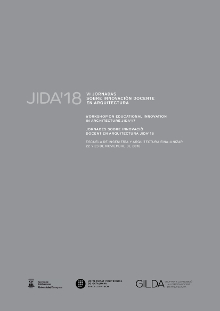Uso docente de la red social “Instagram” en la asignatura de Proyectos 1
DOI:
https://doi.org/10.5821/jida.2018.5511Resumen
Esta comunicación aborda la incorporación de la Red Social Instagram, como herramienta complementaria, en el desarrollo de la asignatura de Proyectos 1. La familiaridad del alumnado con esta aplicación supuso el requisito necesario para un experimento docente cuyas pretensiones originales –de carácter únicamente informativo- se vieron desbordadas por el creciente debate generado en el Grupo. La selección, por parte del docente, de referencias del ámbito teórico, sumada a la exposición de trabajos –principalmente fotografías de maquetas- de cada alumno retroalimentaron e impulsaron tanto la investigación personal proyectada en el diálogo en el aula, como la búsqueda de reconocimiento individualizado de resultados puestos al servicio de la crítica grupal –número de “like”-.El conflicto entre información-conocimiento o consumo-aprendizaje enmarca unas conclusiones que justifican el experimento, a pesar de alertar del peligro de infoxicación, y reconocer que el saber solo proviene de la información convenientemente procesada.
Citas
AICHER, Otl, (2007). El mundo como proyecto. Barcelona: Editorial Gustavo Gili SL
BAJTÃN, Mijail (1989). TeorÃa y estética de la novela. Trad, de Helena S Kriukova y Vicente Cazcarra. Madrid: Taurus.
BAUMAN, Zygmunt. (2003). Modernidad LÃquida. México DF: Editorial Fondo de Cultura Económica.
BERGMANN, J., & SAMS, A. (2012). Flip your classroom: Reach every student in every class every day. International society for technology in education.
COLOMINA, Beatriz. (2010). Privacidad y Publicidad. La arquitectura moderna como medio de comunicación de masas. Murcia: Cendeac y Colegio Oficial de Arquitectos de Murcia.
HABERMAS, J. (1994). Historia y crÃtica de la opinión pública: la trasnformación estructural de la vida pública. Barcelona: Gustavo Gili.
INNERARITY, D. (2011). La democracia del conocimiento. Por una sociedad inteligente. Barcelona: Editorial Paidós.
Mc LUHAN, Marshall & BARRINGTON, Nevitt. (1972). Take Today: the executive as dropout. Recogido en CARMONA, Octavio I. (2008). El prosumidor. El actor comunicativo en la sociedad de la ubicuidad. Palabra Clave, Vol.11, nº1, p.2
MILLÃS, Juan José. (2018). “Ah, era esto†en El PaÃs, 4 de Mayo de 2018, https://elpais.com/elpais/2018/05/03/opinion/1525348888_646303.html [Consulta: 10 de Julio 2018]
MIRANDA REGOJO-BORGES, Antonio. (1998). MetacrÃtica. (Manual para la critica de arquitectura).
SENNETT, Richard. (2009). El artesano. Barcelona: Editorial Anagrama SA.
STEHR, Nico. (2003). Wissenspolitik. Die Ãœberwachung des Wissens. Frankfurt am Main: Suhrkamp. Taschenbuch Verlag.
TOFFLER, Alvin. (1982). La tercera ola,1980. Madrid: Plaza & Janés.






















